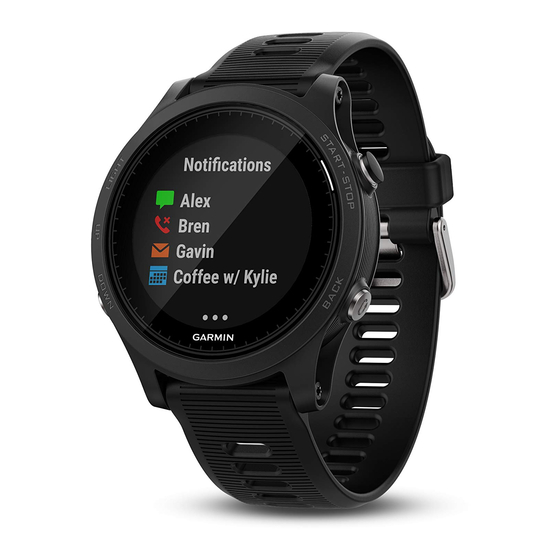Garmin FORERUNNER 935 Руководство пользователя - Страница 13
Просмотреть онлайн или скачать pdf Руководство пользователя для Смотреть Garmin FORERUNNER 935. Garmin FORERUNNER 935 46 страниц.
Также для Garmin FORERUNNER 935: Руководство пользователя (42 страниц)

The metronome starts automatically.
9
During your run, select UP or DOWN to view the metronome
screen.
10
If necessary, hold
to change the metronome settings.
Extended Display Mode
You can use Extended Display mode to display data screens
from your Forerunner device on a compatible Edge
during a ride or triathlon. See your Edge owner's manual for
more information.
Setting Up Your User Profile
You can update your gender, birth year, height, weight, heart
rate zone, and power zone settings. The device uses this
information to calculate accurate training data.
1
Hold
.
2
Select Settings > User Profile.
3
Select an option.
Fitness Goals
Knowing your heart rate zones can help you measure and
improve your fitness by understanding and applying these
principles.
• Your heart rate is a good measure of exercise intensity.
• Training in certain heart rate zones can help you improve
cardiovascular capacity and strength.
If you know your maximum heart rate, you can use the table
(Heart Rate Zone Calculations, page
heart rate zone for your fitness objectives.
If you do not know your maximum heart rate, use one of the
calculators available on the Internet. Some gyms and health
centers can provide a test that measures maximum heart rate.
The default maximum heart rate is 220 minus your age.
About Heart Rate Zones
Many athletes use heart rate zones to measure and increase
their cardiovascular strength and improve their level of fitness. A
heart rate zone is a set range of heartbeats per minute. The five
commonly accepted heart rate zones are numbered from 1 to 5
according to increasing intensity. Generally, heart rate zones are
calculated based on percentages of your maximum heart rate.
Setting Your Heart Rate Zones
The device uses your user profile information from the initial
setup to determine your default heart rate zones. You can set
separate heart rate zones for sport profiles, such as running,
cycling, and swimming. For the most accurate calorie data
during your activity, set your maximum heart rate. You can also
set each heart rate zone and enter your resting heart rate
manually. You can manually adjust your zones on the device or
using your Garmin Connect account.
1
Hold
.
2
Select Settings > User Profile > Heart Rate.
3
Select Max. HR, and enter your maximum heart rate.
You can use the Auto Detect feature to automatically record
your maximum heart rate during an activity
Performance Measurements Automatically, page
4
Select LTHR > Enter Manually, and enter your lactate
threshold heart rate.
You can perform a guided test to estimate your lactate
threshold
(Lactate Threshold, page
Auto Detect feature to automatically record your lactate
threshold during an activity
Measurements Automatically, page
5
Select Resting HR, and enter your resting heart rate.
You can use the average resting heart rate measured by your
device, or you can set a custom resting heart rate.
Training
®
device
7) to determine the best
(Detecting
13).
15). You can use the
(Detecting Performance
13).
6
Select Zones > Based On.
7
Select an option:
• Select BPM to view and edit the zones in beats per
minute.
• Select %Max. HR to view and edit the zones as a
percentage of your maximum heart rate.
• Select %HRR to view and edit the zones as a percentage
of your heart rate reserve (maximum heart rate minus
resting heart rate).
• Select %LTHR to view and edit the zones as a percentage
of your lactate threshold heart rate.
8
Select a zone, and enter a value for each zone.
9
Select Add Sport Heart Rate, and select a sport profile to
add separate heart rate zones (optional).
10
Repeat the steps to add sport heart rate zones (optional).
Letting the Device Set Your Heart Rate Zones
The default settings allow the device to detect your maximum
heart rate and set your heart rate zones as a percentage of your
maximum heart rate.
• Verify that your user profile settings are accurate
Your User Profile, page
• Run often with the wrist or chest heart rate monitor.
• Try a few heart rate training plans, available from your
Garmin Connect account.
• View your heart rate trends and time in zones using your
Garmin Connect account.
Heart Rate Zone Calculations
Zone % of
Perceived Exertion
Maximum
Heart Rate
1
50–60%
Relaxed, easy pace,
rhythmic breathing
2
60–70%
Comfortable pace,
slightly deeper
breathing, conversation
possible
3
70–80%
Moderate pace, more
difficult to hold
conversation
4
80–90%
Fast pace and a bit
uncomfortable, breathing
forceful
5
90–100%
Sprinting pace,
unsustainable for long
period of time, labored
breathing
About Lifetime Athletes
A lifetime athlete is an individual who has trained intensely for
many years (with the exception of minor injuries) and has a
resting heart rate of 60 beats per minute (bpm) or less.
Setting Your Power Zones
The values for the zones are default values based on gender,
weight, and average ability, and may not match your personal
abilities. If you know your functional threshold power (FTP)
value, you can enter it and allow the software to calculate your
power zones automatically. You can manually adjust your zones
on the device or using your Garmin Connect account.
1
Hold
.
2
Select Settings > User Profile > Power Zones > Based On.
3
Select an option:
• Select Watts to view and edit the zones in watts.
(Setting Up
7).
Benefits
Beginning-level
aerobic training,
reduces stress
Basic cardiovascular
training, good
recovery pace
Improved aerobic
capacity, optimal
cardiovascular training
Improved anaerobic
capacity and
threshold, improved
speed
Anaerobic and
muscular endurance,
increased power
7
